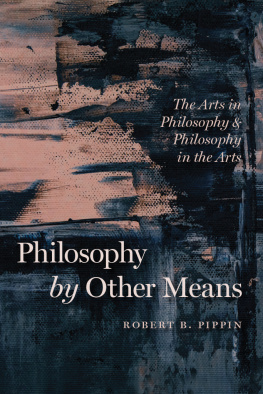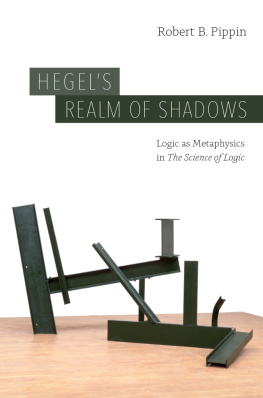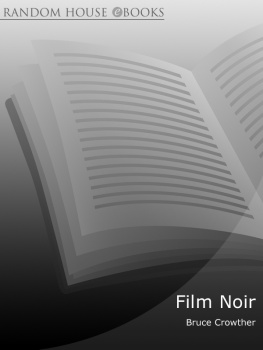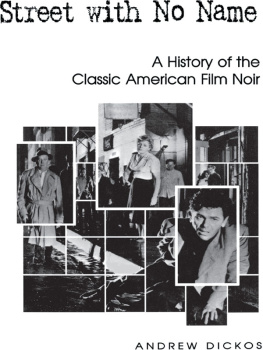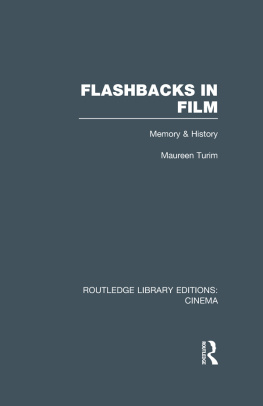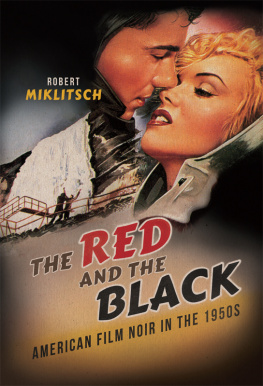Robert B. Pippin - Fatalism in American Film Noir: Some Cinematic Philosophy
Here you can read online Robert B. Pippin - Fatalism in American Film Noir: Some Cinematic Philosophy full text of the book (entire story) in english for free. Download pdf and epub, get meaning, cover and reviews about this ebook. year: 2012, publisher: University of Virginia Press, genre: Art. Description of the work, (preface) as well as reviews are available. Best literature library LitArk.com created for fans of good reading and offers a wide selection of genres:
Romance novel
Science fiction
Adventure
Detective
Science
History
Home and family
Prose
Art
Politics
Computer
Non-fiction
Religion
Business
Children
Humor
Choose a favorite category and find really read worthwhile books. Enjoy immersion in the world of imagination, feel the emotions of the characters or learn something new for yourself, make an fascinating discovery.

- Book:Fatalism in American Film Noir: Some Cinematic Philosophy
- Author:
- Publisher:University of Virginia Press
- Genre:
- Year:2012
- Rating:5 / 5
- Favourites:Add to favourites
- Your mark:
- 100
- 1
- 2
- 3
- 4
- 5
Fatalism in American Film Noir: Some Cinematic Philosophy: summary, description and annotation
We offer to read an annotation, description, summary or preface (depends on what the author of the book "Fatalism in American Film Noir: Some Cinematic Philosophy" wrote himself). If you haven't found the necessary information about the book — write in the comments, we will try to find it.
Fatalism in American Film Noir: Some Cinematic Philosophy — read online for free the complete book (whole text) full work
Below is the text of the book, divided by pages. System saving the place of the last page read, allows you to conveniently read the book "Fatalism in American Film Noir: Some Cinematic Philosophy" online for free, without having to search again every time where you left off. Put a bookmark, and you can go to the page where you finished reading at any time.
Font size:
Interval:
Bookmark:
FATALISM IN AMERICAN FILM NOIR
PAGE-BARBOUR LECTURES FOR 2010

University of Virginia Press
2012 by the Rector and Visitors of the University of Virginia
All rights reserved
Printed in the United States of America on acid-free paper
First published 2012
9 8 7 6 5 4 3 2 1
LIBRARY OF CONGRESS CATALOGING-IN-PUBLICATION DATA
Pippin, Robert B., 1948
Fatalism in American film noir : some cinematic philosophy /
Robert B. Pippin.
p. cm. (Page-Barbour lectures for 2010)
Includes bibliographical references and index.
ISBN 978-0-8139-3189-0 (cloth : alk. paper) ISBN 978-0-8139-3201-9 (e-book)
1. Film noirUnited StatesHistory and criticism. 2. Fate and fatalism in motion pictures. I. Title.
PN 1995.9.F54P58 2011
791.436556dc23
2011018971
In memory of Miriam Bratu Hansen
CONTENTS
Trapped by Oneself in Jacques Tourneurs
Out of the Past
A Deliberate, Intentional Fool in Orson Welless
The Lady from Shanghai
Sexual Agency in Fritz Langs
Scarlet Street
Why Didnt You Shoot Again, Baby?:
Concluding Remarks
ACKNOWLEDGMENTS
This work in early form began as the 2010 Page-Barbour Lectures at the University of Virginia, and I am grateful to Walter Jost and Talbott Brewer for the invitation to deliver the lectures and for their hospitality during my stay. The three lectures were also given at the University of Chicago in the same year under the sponsorship of the Karla Scherer Center for the Study of American Culture, and I am grateful to Eric Slauter for arranging these highly fruitful conversations. An earlier version of appeared in Critical Inquiry 37, no. 5 (2010), and I am grateful to the editors of both journals for permission to reprint. Versions of chapters were presented as lectures at Stanford University, Duke University, Rutgers University, Dartmouth College, Williams College, Colorado College, Wesleyan University, Columbia University, the Wissenschaftskolleg zu Berlin, the Siemens Stiftung in Munich, and lUniversit Paris i/Panthon-Sorbonne, and I profited from the questions and discussions. I am especially indebted to a number of people for discussions about the lectures and the films, especially to Lanier Anderson, Jim Conant, Michael Fried, Tom Gunning, Miriam Hansen, Joshua Landy, Ruth Leys, Toril Moi, Dan Morgan, Gabriel Palitz, Thomas Pavel, Christine Stansell, George Wilson, and Robert von Hallberg.
I owe a special debt to my friend and colleague Miriam Bratu Hansen, the founder of Chicagos Cinema and Media Studies program and an inspiring presence at discussions of film, literature, and much else on campus. Miriam died shortly after the completion of this book, much of which she read and generously commented on. This book is dedicated to her memory.
FATALISM IN AMERICAN FILM NOIR
INTRODUCTION
Motion pictures of actors representing fictional characters doing things engage our responsiveness in manifold ways. Some responses are distinctly aesthetic (in the original sense of sensual), have to do with credibility, compellingness, excitement, concern, fear, anxiety, and identification, and most of all simply with pleasure; perhaps a distinctly aesthetic pleasure, perhaps a distinctly cinematic aesthetic pleasure. These are relatively (though not completely) unreflective responses, and so some criterion for sensible and affective success must be observed or the photographed action aesthetically fails and there is no pleasure or engaged response. We are bored, repelled, confused.
Another kind of responsiveness has to do with commercial aspects of the industry and the status of movies as commodities. We see (we pay to see) recognizable movie stars usually repeating specific character types, in genres so established that our expectations and reactions are predictable, and we seem to enjoy such predictability and repetition.
Some responses are possible only in the medium of film. The speed of the narration and the point of view and the distance from the actors can be controlled and varied as in no other medium, and audiences originally had to learn, had to be taught, how to follow such narratives and adjust for such points of view.
Some responses are more complexly psychological. We seem to take a distinct sort of interest in being invisibly present at filmed action, especially at filmed moments of great intimacy or violence or terror. Moreover, as the technical powers of movies grow and we are able to represent compellingly almost any sort of world or event, movies seem more and more connected with the deepest human fantasies, and the intensity of the pleasure we take in the experience of such fantasies has begun to dwarf what is possible in all the other arts. Such a pleasure has inspired many sorts of explanations, many of them, understandably, complex psychoanalytic explanations.
But some responses engage our intellectual faculties, understood in a broad sense, especially with respect to what characters do, with respect to actions. We have to make sense of what characters do, and for classic Hollywood realist narratives, we bring to bear on that question the ways we attempt to make sense of our own and others actions.
There are certainly great gaps between what we do when we try to understand what we and others normally do and what we do in trying to understand moving pictures of actions. Movie characters are not, of course, real people, and perhaps ultimately these cinematic images make some specific sort of sense to us only within the artificial and varying boundaries set by a medium-specific aesthetic object, and in an experience that is quite distinct from ordinary perceptual and emotional experience, an aesthetic experience. Moreover, screen characters are the products of such a dizzying array of factorsthe screenplay, the mise en scne, the particular requirements of the studio where it was made, the director, the actors performancethat the shape, strains, and tensions in a given character can be multiply overdetermined. But while screen images are not persons, and film narration is sui generis, there cannot be two completely distinct modalities of such sense-making: one for ordinary life and another governed by an incommensurable movie or dramatic or diegetic or aesthetic logic. Motion pictures of characters, whatever else they are, are still representative, doubly representative, actually, since the complex, imputed author of the film (which might include all the factors listed above) This all would get more complicated still when we try then to take full account of the distinct aesthetic medium of film and the uniqueness of the film-viewing experience, but there is an enormous amount of great philosophical importance going on when we try to explain what I am identifying as the minimum conditions for the intelligibility of filmed action, and that attempt need not prejudge or mislead us about these further issues. They are just distinct questions.
Moreover, we need this overlap at the outset of any discussion because the brilliant achievement of the core group of great noirs is to show how terribly limited explanations that focus on the moral psychology of individuals turn out to be, given how little of the future they can actually effect as individuals (the explanation of what happens does not finally lie with what they try to do and why they try to do it, however natural that assumption is to realist narratives), given how unstable, provisional, and often self-deceived are their claims to self-knowledge, and given how little in control they are of their criteria for deliberation, how absurd it is to expect them to be able to step back, as it is said, from their commitments and desires and goals and reflectively deliberate about what they ought to do. But this feature, too, is not unique to noirs, film, or aesthetic objects. It is a limitation of which any attempt at action explanation in life must also take account. We shall have occasion in the films under discussion to see how important the opening overlap expectation is in order to set us up for the disappointment involved in discovering how little attention to the subjective inner life of the characters is relevant to what happens.
Next pageFont size:
Interval:
Bookmark:
Similar books «Fatalism in American Film Noir: Some Cinematic Philosophy»
Look at similar books to Fatalism in American Film Noir: Some Cinematic Philosophy. We have selected literature similar in name and meaning in the hope of providing readers with more options to find new, interesting, not yet read works.
Discussion, reviews of the book Fatalism in American Film Noir: Some Cinematic Philosophy and just readers' own opinions. Leave your comments, write what you think about the work, its meaning or the main characters. Specify what exactly you liked and what you didn't like, and why you think so.

